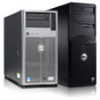Dell PowerEdge XL 5133-4 MXL 10/40GbE Switch IO Module FTOS Command Reference - Page 78
DCBX Port Roles, Default DCBX port role
 |
View all Dell PowerEdge XL 5133-4 manuals
Add to My Manuals
Save this manual to your list of manuals |
Page 78 highlights
www.dell.com | support.dell.com DCBX Port Roles The following DCBX port roles are auto-configured on an Aggregator to propagate DCB configurations learned from peer DCBX devices internally to other switch ports: • Auto-upstream: The port advertises its own configuration to DCBX peers and receives its configuration from DCBX peers (ToR or FCF device). The port also propagates its configuration to other ports on the switch. The first auto-upstream that is capable of receiving a peer configuration is elected as the configuration source. The elected configuration source then internally propagates the configuration to auto-downstream ports. A port that receives an internally propagated configuration overwrites its local configuration with the new parameter values. When an auto-upstream port (besides the configuration source) receives and overwrites its configuration with internally propagated information, one of the following actions is taken: • If the peer configuration received is compatible with the internally propagated port configuration, the link with the DCBX peer is enabled. • If the received peer configuration is not compatible with the currently configured port configuration, the link with the DCBX peer port is disabled and a syslog message for an incompatible configuration is generated. The network administrator must then reconfigure the peer device so that it advertises a compatible DCB configuration. The configuration received from a DCBX peer or from an internally propagated configuration is not stored in the switch's running configuration. On a DCBX port in an auto-upstream role, the PFC and application priority TLVs are enabled. ETS recommend TLVs are disabled and ETS configuration TLVs are enabled. • Auto-downstream - The port advertises its own configuration to DCBX peers but is not willing to receive remote peer configuration. The port always accepts internally propagated configurations from a configuration source. An auto-downstream port that receives an internally propagated configuration overwrites its local configuration with the new parameter values. When an auto-downstream port receives and overwrites its configuration with internally propagated information, one of the following actions is taken: • If the peer configuration received is compatible with the internally propagated port configuration, the link with the DCBX peer is enabled. • If the received peer configuration is not compatible with the currently configured port configuration, the link with the DCBX peer port is disabled and a syslog message for an incompatible configuration is generated. The network administrator must then reconfigure the peer device so that it advertises a compatible DCB configuration. The internally propagated configuration is not stored in the switch's running configuration. On a DCBX port in an auto-downstream role, all PFC, application priority, ETS recommend, and ETS configuration TLVs are enabled. Default DCBX port role: Uplink ports are auto-configured in an auto-upstream role. Server-facing ports are auto-configured in an auto-downstream role. 64 | Data Center Bridging (DCB)















